We hadn't originally planned our two-week vacation to Cancun Mexico for its affordability but — when weeks later I found myself unemployed (like the rest of the planet) — it seemed like a prescient choice. In addition to its favorable exchange rate, Mexico has fascinating archeological sites and a rich history that would allow us to slip in a bit of culture between Margaritas.
Cancun Mexico is a sunny paradise on the Gulf side.
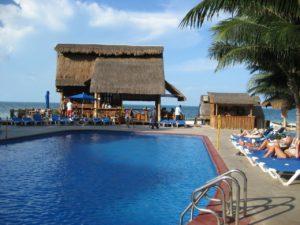
We chose two new cities to visit: Cancun and Mazatlan. Cancun for its Maya ruins (Chichen Itza, Tulum and Coba). And Mazatlan for its guilt-free, lack of anything really must-see or -do.
When we arrived in sunny Cancun Mexico the next day at noon, beaten and bleary-eyed from our red-eye flight, it was a toasty 84-degrees. We hit the beach and immediately fell unconscious in the Caribbean's warm embrace for what seemed like, and actually turned out to be, a really long time.
Long enough that it was already dark when we next opened our eyes, so we paradoxically headed uptown to go downtown for dinner. We ate at a vegetarian place named “100% Natural” but only loved it 97%. We had a great tasting, healthy meal — including a bottle of Viognier —and yet the most expensive part of dinner was the US$15 cab ride back to the resort.
Cancun is apparently Mayan for “alcohol poisoning.”
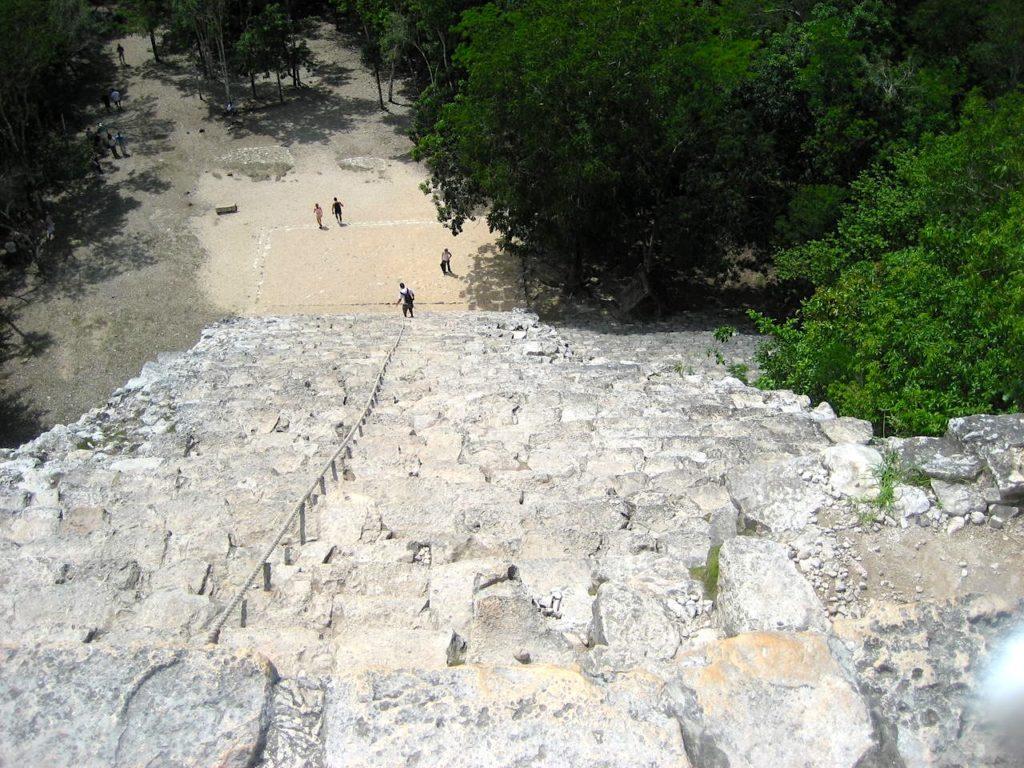
To be honest, I had a different image of Cancun Mexico in my mind when we first planned the trip. I was thinking the city was a thriving, hedonistic beach-metropolis; a coastal Las Vegas with skyscrapers and neon-lit dance clubs. The reality, though, turned out to be more…rustic than that. Cancun's downtown was, well, a bit run down. Many of its sidewalks were crumbling and street signs missing — all of which might have been expected in a centuries-old city like Roma or Firenze — but was kind of surprising when you considered that Cancun has only been a tourist destination since 1971.
In fact, the entire area owes its existence to a Mexican planning board that was looking for an area they could develop to attract American tourists or, at least, American money. A place where both young men and women could drink until they vomited and display their naked genitalia without fear of moral or legal reprisal.
Cancun Mexico is a better name than the original.
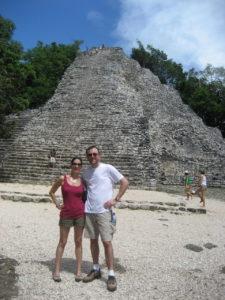
Originally nothing but swampland lousy with mosquitoes and snakes (before the government trucked in pesticides and pavement), the area in question was renamed “Cancun” a word derived from an unpronounceable Mayan word which meant roughly, “nest of snakes.”
And, while we didn't see any reptile or insect infestations, Cancun Mexico was certainly overrun by shamelessly pasty-white tourists like myself. And honestly, I'm not sure if that's much of an improvement over the mosquitos and snakes.
Getting around El Centro (aka, “Downtown”) wasn't as easy as it could have been. Cancun wasn't built on a grid even though the ‘grid' concept had been around for hundreds of years at the time Cancun was built.
We got lost a lot in Cancun Mexico.
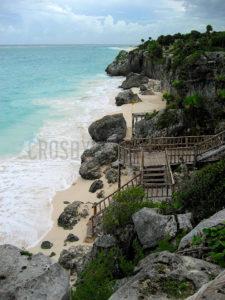
Rather, the city had a pretty haphazard layout — and despite our being somewhat savvy world travelers (we even had a freakin' map!), we still had to pay some local guy on Tenkah Avenue ten pesos to find the bus stop we needed.
Still, to be fair, when people speak of Cancun Mexico, they are usually referring to the tourist areas, like the Zona Hotela, a strip of white, sandy beach jammed with massive resorts and monster hotels. It's where Cancun looked its best, usually through beer goggles.
The Zona Hotela was a 5-mile strip of white sand stretching from El Centro south, encompassing an equally long inland lagoon for some reason.
The worst part of Cancun Mexico is its tourist zone.
El Zona was choked with monolithic hotels and mega-resorts facing the azure waters of the Gulf of Mexico, while tacky theme restaurant/bars like Hooters, Margaritavilles, and Señor Frog's lined the inside lagoon. That way, you're provided with a picturesque view of water whether you're laid out at the beach, or face-down at a bar.
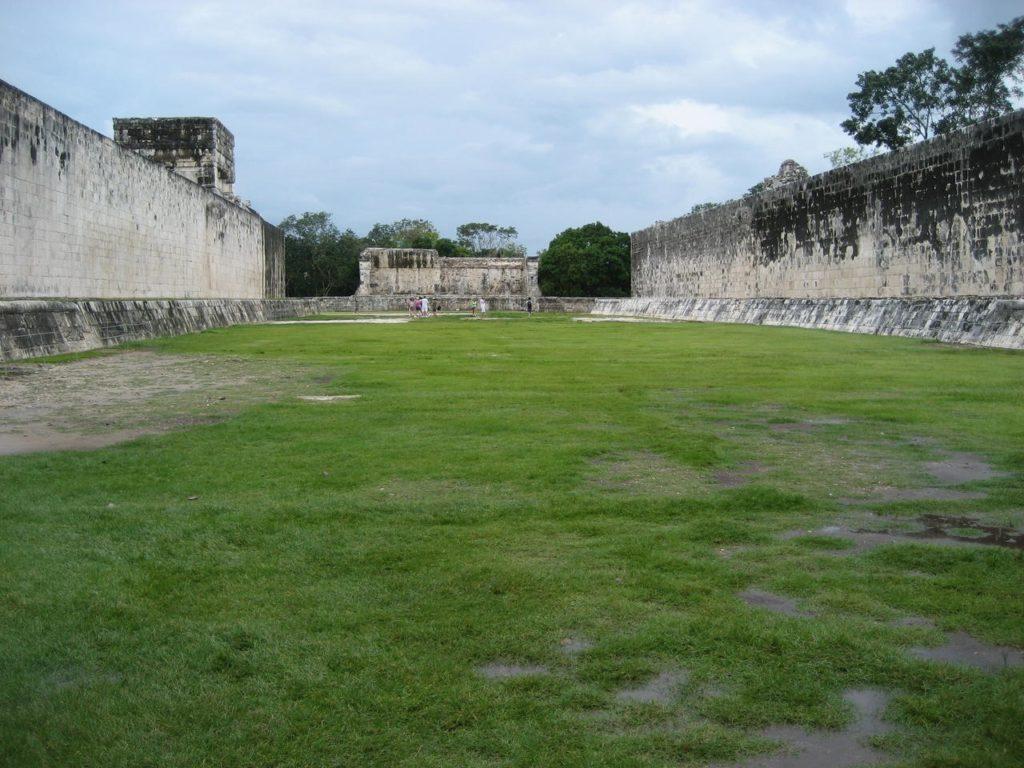
Our more modest resort, the Imperial Fiesta Club @ Casa Maya, was located near the northern entrance of El Zona. However, its less than ideal location was made irrelevant by the presence of a super-convenient city bus that passed by every 10 minutes or so.
For about US$0.65, we were soon back in El Centro walking the crumbling sidewalks and looking for La Habichuela, a pretty good Yucatan-style restaurant. Afterward, we walked to the nearby “Mercado 28” which sounded like a good place to shop for interesting and authentic goods available nowhere else in Cancun Mexico, but wasn't.
Still, we hadn't come to Cancun Mexico to buy cheap trinkets that would break before we got them home. No, we were there to buy cheap Maya trinkets that would break before we got them home. And for that, we had to do some driving.
Coba is Mayan for “acrophobia.”
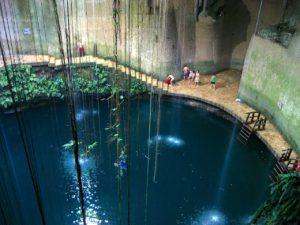
The next day, we rose brutally early to go see two significant pre-Columbian Maya sites not far from Cancun Mexico. Coba, which had the distinction of possessing the second-largest pyramid in Central America (Guatemala has the tallest). And Tulum, which supposedly had a killer oceanfront view.
Rather than brave Mexico's questionable Interstate system by ourselves, we opted to let someone else drive us out to the ruins. (In hindsight, we could have easily driven the 3-hour trip ourselves, but we were on vacation and frequently drunk. Besides, we would have missed out on our tour guide's helpful blathering on about all things Maya: “Established in the Yucatan around 2600 B.C., the Maya rose to prominence around A.D. 250 in present-day Mexico, Guatemala, Belize, and Honduras.”
We went to Coba to see its castle.

After what seemed like an eternity, we arrived at the Maya town called Coba. And to be honest, the place was in worse shape than Cancun Mexico. Coba was literally in ruins — it didn't look like any Maya had lived there for decades, or longer — I mean, you'd think they'd have mentioned that fact in the tour brochure! Its egregious disrepair was a shame, because there was ample proof of a once-thriving civilization.
The most obvious evidence was El Castillo (aka, “The Castle” or pyramid). At over 60-meters high, El Castillo was an impressive feat of stacking rocks on top of other rocks. This rough-hewn pyramid stabbed skyward from a clearing deep in the Yucatan jungle and was visible for miles around. It wasn't surprising, therefore, to discover that—from the top of this awesome monument—one could also see for miles around. How do we know? They actually let us climb the damn thing. No, seriously. (Do they not have OSHA here?)

With nothing more than a thick rope to grab, the Mexican government let out-of-shape, couch-potatoesque, American tourists like me climb the 180 or so feet to the top of El Castillo without signing any legal releases first! Their unquestioning faith in the protective power of the feathered snake god, Kukulcan, was almost enough to convert me to the religion on the spot.
From the summit of El Castillo, we saw what ancient Maya priests probably had seen when they weren't pulling the still-beating heart from a live, Maya warrior's chest: namely, the surrounding compound, complete with a Great Ball Court, a dense forest that went on for miles, and five crocodile-infested lakes where CSI:Maya detectives would likely find a lot of dead warrior remains.
Tulum is Mayan for…oh, let's say, “beach party house.”
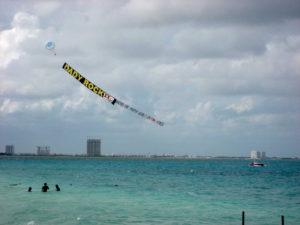
In contrast to the other ruins we had visited outside Cancun Mexico, Tulum didn't really have a pyramid to climb, but being built on a cliff 40-feet above the beautiful Caribbean, it didn't really need one. As Coba's first line of defense against invading forces from the sea, Tulum was the most fortified of the Maya sites we saw.
The massive 400-meter long stone wall surrounding the place was our first clue that the name Tulum might be Mayan for ‘walled city.' But Tulum was a significant seaport and trading outpost, too. In fact, the Maya had built a road all the way from Tulum to Coba that was paved with a white substance that reflected moonlight—I forget what they called it, but it wasn't cocaine—making night travel much easier (and probably safer than driving Mexico's Interstate system).
Chichen Itza is Mayan for “tourist attraction.”

Chichen Itza, the most well-known Maya site near Cancun Mexico, is home to Castillo de Kukulcan which, at 24-meters, is a lot shorter than the pyramid in Coba despite being built on top of a smaller, pre-existing pyramid (kinda like a Russian nesting doll).
Chichen Itza's El Castillo is remarkably well-preserved, considering all the athletes who've been filmed running up and down its ancient steps for TV commercials. Disappointingly, we weren't allowed to climb the pyramid ourselves because, back in 2005, an 80-year-old lady adventurer slipped and fell to her death. So instead, we were forced to wander the compound, learning stuff instead.
The most interesting thing we learned against our will was that the Castle was designed with a number of very odd acoustic properties. By standing in front of the main stairs—which, from the side, cleverly looks like a serpent climbing down!—you can clap loudly and hear freaky echoes all around the compound that supposedly sound like their winged snake-god or something. I forget what its utility was, but it had some kind of practical purpose at the time (beyond entertaining tourists, I mean).
The Great Ball Court is where the Maya played ball.

The Maya put that same acoustic wizardry to work when they built El ThunderDome — I mean, the Great Ball Court. This massive arena was used to showcase their national sport, Pok Ta Pok. And while every Maya city had its own Pok Ta Pok court, this monstrous 550-foot long grass one was much…well, greater.
Unlike most courts which had walls angled at 45-degrees, the Great Ball Court had steep, 90-degree vertical walls made of strategically sized and placed wall stones. The court's clever design let someone stand in the North Temple and converse in a normal tone of voice with another person in the South Temple over 500-feet away. Presumably, this allowed the Maya ruler to be heard over the crowd noise as he bellowed that timeless proclamation, “Citizens of Maya! Let us prepare ourselves to ruuummmmmbbbbble!”
Before basketball, there was “Pok Ta Pok.”
Pok Ta Pok was a combination of basketball, European football, and Canadian hockey. Each team of seven players attempted to keep a ball off the ground using only their hips, knees, and elbows. The object of the game was to get the ball over to a captain who was running along the sideline wall's ledge, located about 4-feet above the field. The team captain then used a kind of stick to hit the ball through a stone hoop in the top/middle of the stone wall.
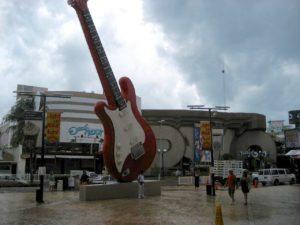
The difficulty of scoring was so great that games often took days to complete, which probably wasn't as bad as it sounds, since winning meant that the losing team's captain got to quite literally decapitate your captain (yes, you read that correctly). So the winning team captain was in no hurry to end the game.
The “reasoning” for this apparent barbarism was that, clearly, the winning captain had just proven that he could beat all Earthly competitors and therefore, “logically,” he had to be sent to the afterlife to take on the Maya Gods.
See? It makes perfect sense now, right? Frankly, we should probably apply that theory to pro-athletes today (I'm looking at you, Tom Brady).
What's Mayan for “total dick move”?

As you would expect, the pyramid and other structures at Chichen Itza are all owned by Mexico's Instituto Nacional de Antropología e Historia. However, the land they stand on is owned by the Barbachano family. As we were told the story, this shrewd, but ethically challenged family, bought up the entire archeological site before the government could. The government then attempted, repeatedly, to buy the site, but the Barbachano's wouldn't sell because, you know…money.
Finally, they agreed to sell the monuments, but only if they could keep the land underneath them. This one-sided deal let the family profit from tourism—admission, food, drinks, souvenirs, etc— without any of the costs of maintaining the site. Shrewd, right? No, wait. That's not the right word for it…
Hot and tired? Take a dip in Quintana Roo Cenote.
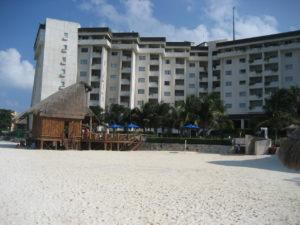
Just outside Cancun Mexico and Chichen Itza is the sacred Quintana Roo Cenote, or “Big-Ass Sinkhole.” It's an impressive cavity in the Earth where some think the Maya performed ritual human sacrifice (those same people also think the Maya were stupid enough to pollute their only inland water supply).
The cenote was considered a very holy place and it was protected and preserved for centuries until the day when someone figured out how much money they'd make charging sweaty tourists to swim in the thing. Now, it's not so holy.
A brief history of Maya. Really brief.
The Maya, it is believed, were descended from Mongolians, which is why they look somewhat different from other Mexicans (they're shorter and more, well…Asian looking). From what we gathered, they came over to the Americas back when Sarah Palin's Alaska and Russia were still connected by a land bridge. Those Maya forbears lived in Alaska until the first Spring arrived, after which they flew to Cancun Mexico, got totally hammered and decided to stay for a few centuries.
Isla de las Mejueles is Mayan for “Island of Women.”
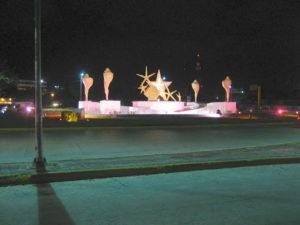
Luckily, there was more to do on Mexico's Yucatan peninsula than just studying ancient cultures. There were brainless activities, too. Like taking a boat over to Isla de las Mejueles, a tiny island just off the coast.
Upon arrival, rather than take a taxi or rent a car, we rented a banged-up 1983 Honda FC50 scooter for US$35 instead and puttered around with no apparent regard for our own safety or the safety of others.
We decided to take a chance with the scooter because the island has one main road that encircles most of it, so my chances of getting us lost were low. Yet having not ridden a motorcycle since I drove my brother's Honda 50CC into a fence as a kid — I was nonetheless an absolute menace to everyone else on the road.

Weaving back and forth like a drunk Kennedy, I still somehow managed to stop the scooter approximately where we wanted, successfully avoiding all the iguanas and small Maya temples everywhere.
Along the way, we stopped at a nice, divey beachfront restaurant known for its Yucatan-style whole fish and Puerco Pibil. Afterward, I piloted us back towards downtown so Amy could shop for some silver and I could return our poor scooter, surprisingly unscathed, all things considered.
The problem with Cancun Mexico.

During our week-long stay in Cancun, we wondered many things: Is Hell this hot? How do you say “Grey Goose” in Spanish? When did we last eat corn?
But mostly, we wondered this: What is it about Cancun Mexico that attracts American douche-bags the way the area used to attract mosquitos? It's veritably teeming with sun-burned “bros” drunkenly spilling three-foot-tall beers on their white-trash wives while thoughtlessly insulting their Mexican hosts like a bad episode of Jersey Shore. Or any episode, really.

We had hoped that by going in October—aka, the ‘shoulder' season—Cancun wouldn't be as crowded. And, truth be told, it wasn't as crowded as it probably could have been.
I guess, it just wasn't crowded with the types of people I wanted. You know, twenty-something girls trying to piss off their fathers by showing up topless in a “Girls Gone Wild” video.
You might get luckier when you go to Cancun Mexico. But, for a less touristy place with fewer Americans, try the inland city of Oaxaca.
